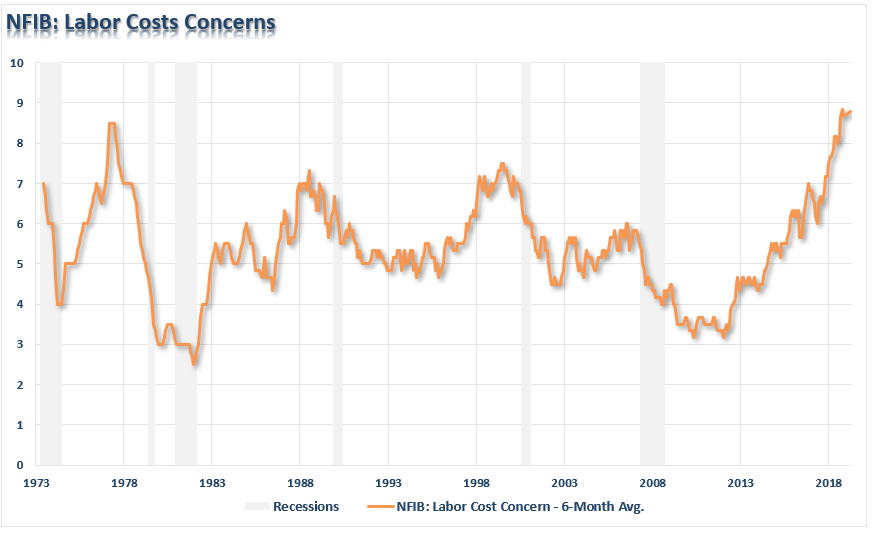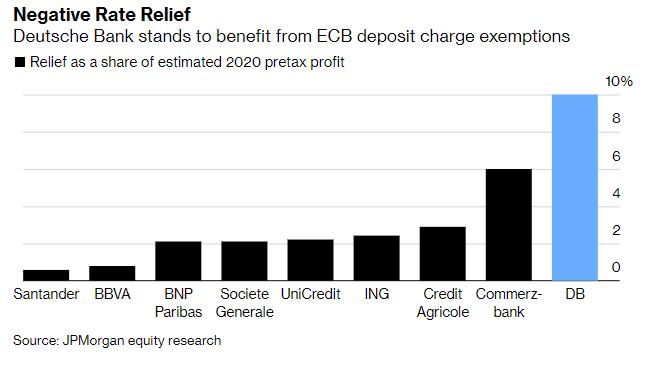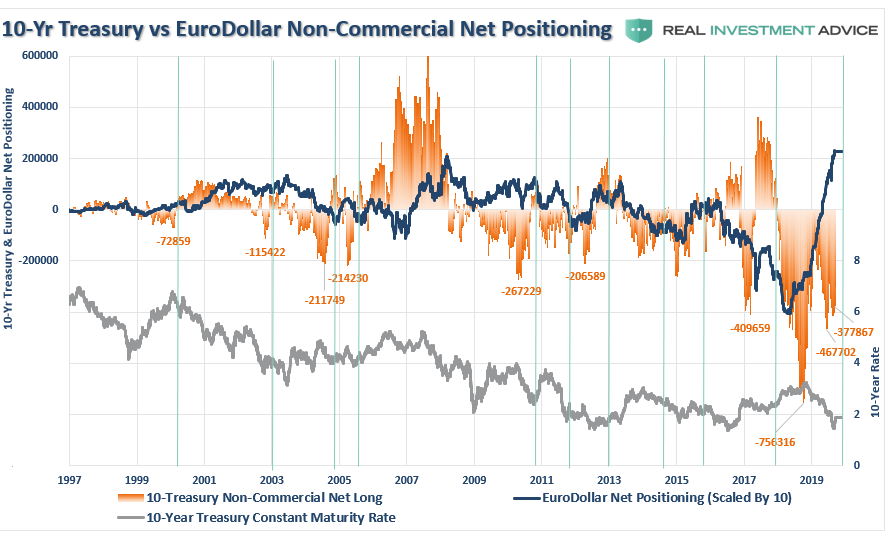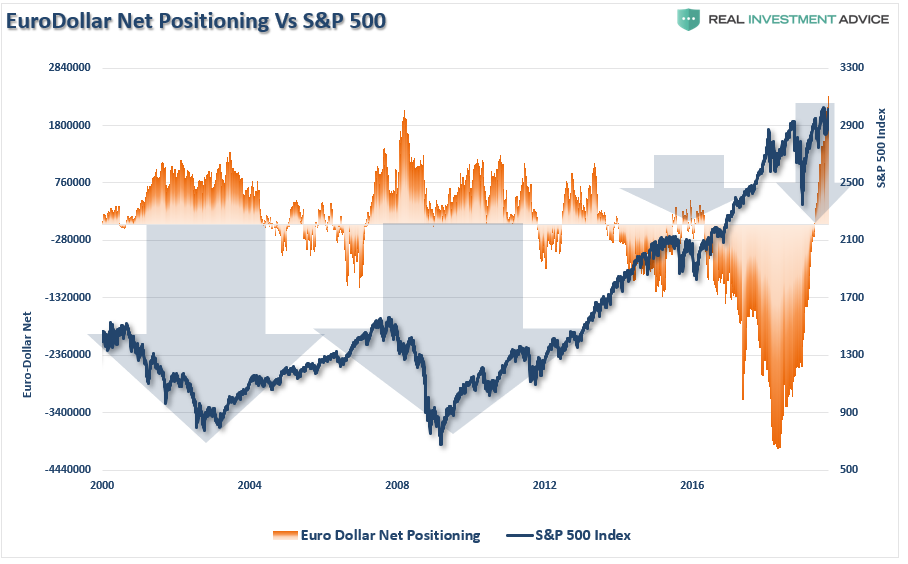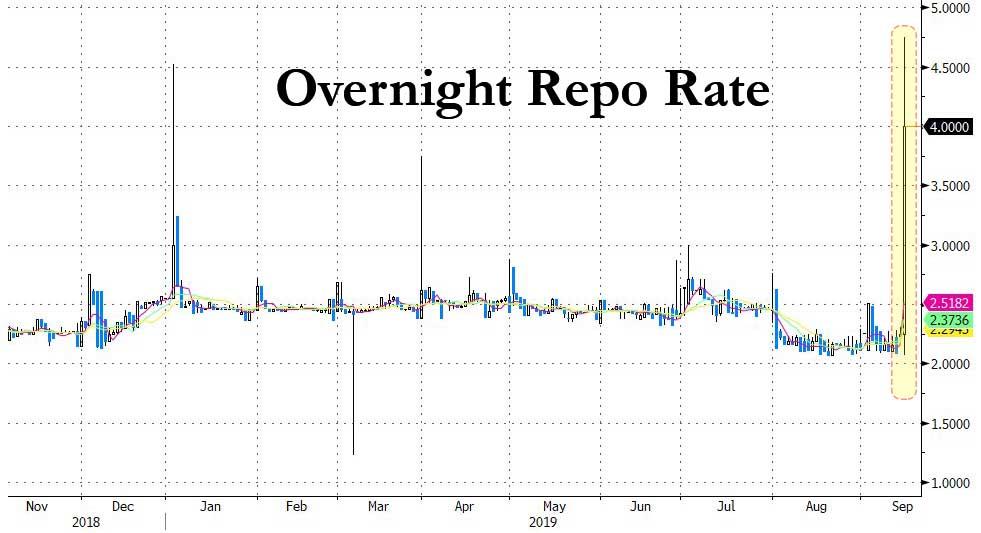by Lance Roberts, Clarity Financial
Over the last few days, the internet has been abuzz with commentary about the spike in interest rates. Of course, the belief is that the spike in rates is “okay” because the market are still rising.
“The yield on the benchmark 10-year Treasury note was poised for its largest weekly rally since November 2016 as investors checked prior concerns that the U.S. was careening toward an economic downturn.” – CNBC
See, one good economic data point and apparently everything is “A-okay.”
Be careful with that assumption as the backdrop, both economically and fundamentally, does not support that conclusion.
While the 10-year Treasury rate did pop up last week, it did little to reverse the majority of “inversions” which currently exist on the yield curve. While we did hit the 90% mark on August 28th, the spike in rates only reversed 2 of the 10 indicators we track.

Nor did it reverse the most important inversion which is the 10-year yield relative to the Federal Reserve rate.
However, it isn’t the “inversion” you worry about.
Take a look at both charts carefully above. It is when these curves “un-invert” which becomes the important recessionary indicator. When the curves reverse, the Fed is aggressively cutting rates, the short-end of the yield curve is falling faster than the long-end as money seeks the safety of “cash,” and a recession is emerging.
As I noted in yesterday’s missive on the NFIB survey, there are certainly plenty of warning signs the economy is slowing down.
“ In turn, business owners remain on the defensive, reacting to increases in demand caused by population growth rather than building in anticipation of stronger economic activity.
What this suggests is an inability for the current economy to gain traction as it takes increasing levels of debt just to sustain current levels of economic growth. However, that rate of growth is on the decline which we can see clearly in the RIA Economic Output Composite Index (EOCI).
All of these surveys (both soft and hard data) are blended into one composite index which, when compared to GDP and LEI, has provided strong indications of turning points in economic activity. (See construction here)”
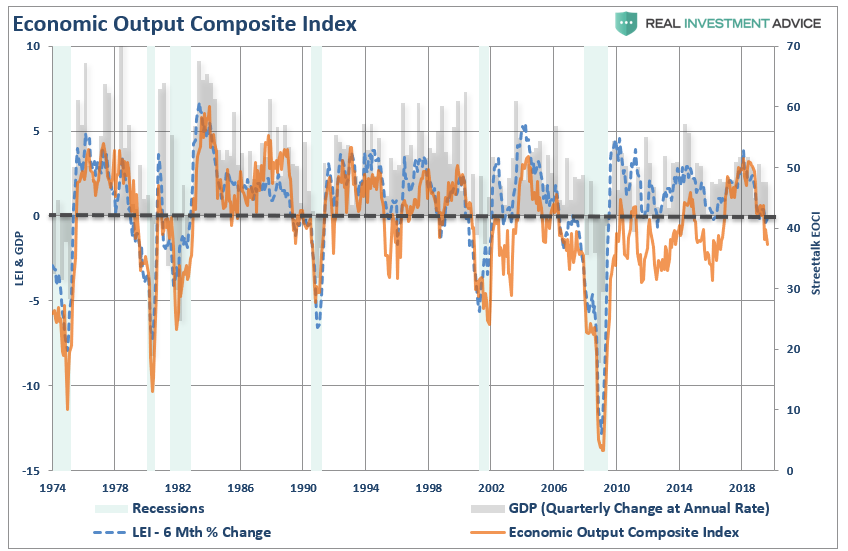
“When you compare this data with last week’s employment data report, it is clear that recession” risks are rising. One of the best leading indicators of a recession are “labor costs,” which as discussed in the report on “Cost & Consequences Of $15/hr Wages” is the highest cost to any business.
When those costs become onerous, businesses raise prices, consumers stop buying, and a recession sets in. So, what does this chart tell you?”
There is a finite ability for either consumers or businesses to substantially sustain higher input costs in a slowing economic environment. While debt can fill an immediate spending need, debt does not lead to economic growth. It is actually quite the opposite, debt is a detractor of growth over the long-term as it diverts productive capital from investment to debt service. Higher interest rates equals higher debt servicing requirements which in turns leads to lower economic growth.
The Risk Of Liquidity
In the U.S., we have dismissed higher rates because of a seemingly strong economy. However, that “strength” has been a mirage. As I previously wrote:
“The IIF pointed out the obvious, namely that lower borrowing costs thanks to central banks’ monetary easing had encouraged countries to take on new debt. Amusingly, by doing so, this makes rising rates even more impossible as the world’s can barely support 100% debt of GDP, let alone 3x that.”
That illusion of economic growth has kept investors blind to the economic slowdown which is already occurring globally. However, with global bond yields negative, the US Treasury is the defacto world’s risk-free rate.
If global bond yields rise, by any significant degree, there is a liquidity funding risk for global markets. This is why, as I noted this past week, the ECB acted in the manner it did to increase liquidity to an already illiquid market. The reason, to bail out a systemically important bank. To wit:
“We had previously stated the Central Banks are going to act to bail out systemically important banks which are on the brink of failure – namely, Deutsche Bank ($DB) Not surprisingly, this was the same conclusion Bloomberg finally arrived at:
“Deutsche Bank AG will benefit the most by far from the European Central Bank’s new tiered deposit rate. Germany’s largest lender stands to save roughly 200 million euros ($222 million) in annual interest paymentsthanks to a new rule that exempts a big chunk of the money it holds at the ECB from the negative rate the central bank charges on deposits. That’s equivalent to 10% of the pretax profit the analysts expect the bank to report in 2020, compared with an average of just 2.5% for the EU banks included in the analysis.”
When you combine rising yields with a stronger U.S. dollar it becomes a toxic brew for struggling banks and economies as the global cost of capital rising is the perfect cocktail for a liquidity crunch.
Liquidity crunches generally occur when yield curves flatten or invert. Currently, as noted above, the use dollar has been rising, as the majority of yield curves remain inverted. This is a strong impediment for economic growth as funding costs are distorted and the price of exports are elevated. This issue is further compounded when you consider the impact of tariffs on the cost of imports which impacts an already weak consumer.
Yes, for now the US economy seems to be robust, and defying the odds of a slowdown. However, such always seems to be the case just before the slowdown begins. It is likely a US downturn is closer than most market participants are predicting.
If we are right, this is going to leave the Federal Reserve in a tough position trying to reverse rates with inflation showing signs of picking up, unemployment low, and stocks near record highs.
Concurrently, bond traders are still carrying one of the largest short positions on record, leaving plenty of fuel to drive rates lower as the realization of weaker economic growth and deteriorating earnings collide with rather excessive stock market valuations.
How low could yields go. In a word, ZERO.
While that certainly sounds implausible at the moment, just remember that all yields globally are relative. If global sovereign rates are zero or less, it is only a function of time until the U.S. follows suit. This is particularly the case if there is a liquidity crisis at some point.
It is worth noting that whenever Eurodollar positioning has become this extended previously, the equity markets have declined along with yields. Given the exceedingly rapid rise in the Eurodollar positioning, it certainly suggests that “something has broken in the system.”
You can see this correlation to equities more clearly in the chart below.
Did Something Break?
The rush by the Central Banks globally to ease liquidity, the ECB restarting the QE, and the Federal Reserve cutting rates in the U.S. suggest there is a liquidity problem somewhere in the system.
Ironically, as I was writing this report, something “broke.”
“Rising recession concerns in August – manifesting in the form of an inverted yield curve, cash hiding in repo, and a slow build in UST supply – kept secured funding pressures at bay. However, the dollar funding storm we warned about has just made landfall as the overnight general collateral repo rate, an indicator of secured market stress and by extension, dollar funding shortages, soared from Friday’s close of 2.25% to a high of 4.750%, a spike of 250bps…” – Zerohedge
This is likely just a warning for now.
Given the disproportionate role of quant-driven strategies, leveraged traders, and the compounded risk of “passive strategies,” there is profound market risk when rates rise to quickly. If the correlations that underpin the multitude of algo-driven, levered, risk-parity portfolios begin to fail, there is more than a significant risk of a disorderly reversion in asset prices.
The Central Banks are highly aware of the risks their policies have grown in the financial markets. Years of zero interest rates, massive liquidity injections, and easy financial standards have created the third asset bubble this century. The problem for Central Bankers is the bubble exists in a multitude of asset classes from stocks to bonds, and particularly in the sub-prime corporate debt market.
As Doug Kass noted on Monday, roughly 80% of loan issuers have no public securities (which serves to limit financial disclosure) and 62% of junk issuers have only 144A bonds.
Source: JPM, Bloomberg Barclays, Prequin
However, here is the key point:
“While a paucity of financial disclosure is not problematic during a bull market for credit, it is a defining feature of a liquidity crisis during a bear market. Human beings are naturally inclined towards fear–even panic–when they are unable to obtain the information they deem critical to their (financial) survival.” – Tad Rivelle, TCW
As noted, liquidity is the dominant risk in the multitude of “passive investing products” which are dependent upon the underlying securities that comprise them. As Tad notes:
“There is yet another feature of this cycle, that while not wholly unique will likely play a major supporting role in the next liquidity crisis: the passive fund. Passive funds are the epitome of the low information investor.
Anyone wonder what might happen should passive funds become large net sellers of credit risk? In that event, these indiscriminate sellers will have to find highly discriminating buyers who–you guessed it–will be asking lots of questions. Liquidity for the passive universe–and thus the credit markets generally–may become very problematic indeed.”
The recent actions by Central Banks certainly suggests risk has risen. Whether this was just an anomalous event, or an early warning, it is too soon to know for sure. However, if there is a liquidity issue, the risk to “uniformed investors” is substantially higher than most realize. As Doug concludes:
“Never before in history have traders and investors been so uninformed. Indeed, some might (with some justification) say that never before in history have traders and investors been so stupid!
But, the conditions of fear and greed have not been repealed — and will contribute to bouts of liquidity changes that range from, and alternate between, where ‘anything goes’ and ‘nothing is believed.’
Arguably, stock and bond prices have veered from the real economy as the cocktail of easing central banks and passive investing strategies produce a constant bid for financial assets, suppresses volatility and, in the fullness of time, will likely cause a liquidity ‘event.’
While the absence of financial knowledge, disclosure and the general lack of skepticism are accepted in a bull market, sadly in a bear market (when everyone is “on the same side of the boat,”) it is a defining feature of a liquidity crisis.”
While those in the mainstream media only focus on the level of the S&P 500 index to make the determination that all is right with the world, a quick look from behind the “rose colored” glasses should at least give you a reason pause.
Risk is clearly elevated, and investors are ignoring the warning signals as markets continue to bid higher.
We saw many of the same issues in 2008 when Bear Stearns collapsed.
No one paid attention then either.
Copyright © Clarity Financial







